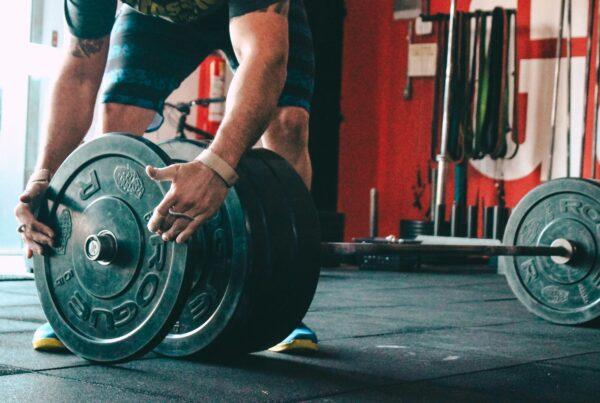Building muscle is not just about looking good, it’s about improving joint support, burning more calories, and enhancing your overall functionality. If you’re looking to build strength and size effectively, here are some top muscle building tips to help you reach your goals.
Key Takeaways:
- Focus on proper nutrition, training with intensity, and getting enough rest for optimal muscle building.
- Warm up before lifting and maintain proper form throughout your exercises.
- Gradually increase weight or sets through progressive overload to stimulate strength gains.
- Incorporate compound exercises that work multiple muscle groups for maximum efficiency.
- Prioritize protein intake, increase calorie intake, and vary protein sources to support muscle and strength growth.
Top Muscle Building Tips
Building muscle offers a multitude of benefits that go beyond just aesthetic improvements. By engaging in muscle-building exercises, you can experience enhanced joint support, increased calorie burning, improved blood levels, and enhanced everyday functionality. Additionally, building muscle can have a positive impact on your appearance, leading to aesthetic benefits and a boost in confidence.
To fully understand the advantages of building muscle, let’s take a closer look at each benefit:
- Joint Support: Developing strong muscles can provide better support and stability to your joints. This can help prevent injuries and reduce joint pain, especially during physical activities and workouts.
- Burn More Calories: Lean muscle mass requires more energy to maintain than fat. By building muscle, you can naturally increase your metabolism and burn more calories even at rest. This can be beneficial for weight management and maintaining a healthy body composition.
- Improved Blood Levels: Regular strength training can positively impact various blood markers, including cholesterol levels, blood pressure, and insulin sensitivity. This can contribute to better overall cardiovascular health and reduce the risk of chronic diseases.
- Enhanced Everyday Functionality: Strong muscles can make daily activities easier and more efficient. Tasks like lifting heavy objects, climbing stairs, or performing household chores become less challenging when you have a well-developed musculature.
Furthermore, the aesthetic benefits of building muscle cannot be overlooked. A toned physique can improve your appearance, boost self-confidence, and positively impact how you feel about yourself. It’s not just about looking good but also feeling strong and capable.
So, whether you’re aiming to improve your overall health, increase your functional abilities, or enhance your aesthetic appeal, building muscle is an essential component of a well-rounded fitness routine.
Building muscle not only benefits your physical health but also enhances your mental well-being. The sense of accomplishment and confidence gained from seeing your progress and achieving your fitness goals is truly empowering.”
What Is Muscle Hypertrophy?
Muscle hypertrophy is the scientific term for the increase in growth of muscle cells, resulting in larger and stronger muscles. It is a common goal for individuals engaged in resistance training and weight lifting, as it contributes to enhanced strength and overall physique.
The process of muscle hypertrophy occurs when muscle fibers experience microscopic damage during resistance training. In response to these microtears, the body initiates repair mechanisms, leading to the growth and thickening of muscle fibers. This adaptation allows the muscles to handle higher loads and become more resistant to future damage.
To promote muscle hypertrophy, it is essential to incorporate progressive overload into your training routine. Progressive overload involves gradually increasing the intensity of your workouts by manipulating variables such as weight, repetitions, or sets. This constant challenge to your muscles stimulates their growth and leads to an increase in muscle fiber size.
| Key Factors for Muscle Hypertrophy | Explanation |
|---|---|
| Resistance Training | Engaging in exercises that involve resistance, such as weightlifting or bodyweight exercises. |
| Progressive Overload | Gradually increasing the demands placed on your muscles to stimulate growth and adaptation. |
| Nutrition | Providing your body with adequate protein and calories to support muscle recovery and growth. |
| Rest and Recovery | Allowing your muscles sufficient time to heal and rebuild between workouts. |
To achieve optimal results, it is important to implement a well-rounded training program that includes a mix of resistance exercises targeting various muscle groups. This ensures that all major muscle groups are stimulated for growth. Additionally, adopting a balanced and nutritious diet, coupled with adequate rest and recovery, will support the hypertrophy process.
Remember, muscle hypertrophy takes time and consistency. By consistently challenging your muscles through resistance training and incorporating progressive overload, you can gradually increase muscle fiber size and achieve your desired results.
 Hypertrophy Types: Myofibrillar vs. Sarcoplasmic
Hypertrophy Types: Myofibrillar vs. Sarcoplasmic
Within the realm of muscle hypertrophy, there are different types that vary in their specific adaptations. Two primary types of hypertrophy are myofibrillar hypertrophy and sarcoplasmic hypertrophy.
Myofibrillar hypertrophy involves an increase in the contractile proteins within muscle fibers, resulting in improved strength and power. This type of hypertrophy is commonly associated with heavy resistance training and lower repetitions.
Sarcoplasmic hypertrophy, on the other hand, focuses on increasing the fluid-filled spaces (sarcoplasm) and energy stores within muscle cells. This type of hypertrophy is often associated with higher repetition ranges and can contribute to a more “pumped” or voluminous appearance.
Both types of hypertrophy can occur simultaneously to varying degrees, depending on the individual’s training program and goals. Incorporating a combination of heavy, low-repetition exercises and higher-repetition exercises can promote balanced hypertrophy and overall muscle development.
Goals for Weight Training
Weight training is a versatile form of exercise that can help you achieve various fitness goals. Whether you’re looking to increase strength, build muscle, improve endurance, or enhance power, weight training can be tailored to suit your needs.
Strength Training: When your goal is to increase strength, you focus on lifting heavier loads to stimulate muscle growth. This type of training involves progressively challenging your muscles by gradually increasing the weight you lift, the number of repetitions, or the number of sets.
Hypertrophy Training: To build muscle size, hypertrophy training is the way to go. This type of training emphasizes increasing the size of your muscle fibers through targeted resistance exercises. By incorporating exercises that target specific muscle groups and gradually increasing the intensity, you can promote muscle growth and achieve a more sculpted physique.
Muscular Endurance Training: If your goal is to improve endurance, muscular endurance training is key. This type of training focuses on improving your muscles’ ability to perform repeated contractions over an extended period. By incorporating high repetition sets and shorter rest periods into your workouts, you can enhance your endurance and stamina.
Power Training: Power training is all about developing explosive strength and speed. This type of training aims to enhance your ability to produce force quickly, which is crucial in activities such as sprinting or jumping. Plyometric exercises, Olympic lifts, and explosive movements are commonly used in power training routines.
Remember, to achieve your goals effectively, it’s essential to have a structured workout plan that incorporates exercises targeting specific muscle groups and progressively increases the intensity over time.
Next, let’s explore some practical strategies to build strength effectively:
Strategies for Building Strength
6 Ways to Build Strength
When it comes to building strength, there are several effective strategies you can incorporate into your fitness routine. By implementing these methods, you can maximize your strength gains and achieve your fitness goals more efficiently.
1. Warm Up Properly
To get the most out of your strength training session, it’s essential to warm up beforehand. This helps increase blood flow to your muscles, loosens your joints, and prepares your body for the upcoming workout. Spend 5-10 minutes performing dynamic stretches, such as arm circles and leg swings, to warm up your muscles and improve flexibility.
2. Focus on Form
Proper form plays a crucial role in building strength effectively and minimizing the risk of injury. Make sure to maintain good posture, engage your core, and use the correct movement patterns for each exercise. If you’re unsure about proper form, consider working with a certified personal trainer who can guide you.
3. Embrace Progressive Overload
In order to build strength, you need to challenge your muscles progressively over time. Gradually increase the weight, sets, or reps of your exercises to push your muscles beyond their comfort zone. This progressive overload stimulates muscle growth and strength gains.
4. Incorporate Compound Exercises
Compound exercises are multi-joint movements that work multiple muscle groups simultaneously. Examples include squats, deadlifts, bench presses, and overhead presses. These exercises not only build overall strength but also improve coordination and functional movement patterns.
5. Stay Consistent
Consistency is key when it comes to building strength. Aim to perform strength training exercises at least two to three times per week, allowing for adequate time for recovery between sessions. Staying consistent with your workouts helps maintain and build muscle mass over time.
6. Seek Professional Guidance
Building strength can be complex, especially if you’re new to weightlifting. Consider seeking help from a certified personal trainer or strength coach who can provide personalized guidance and create a tailored program that aligns with your goals and abilities. They can also ensure that you’re performing exercises correctly and safely.
By implementing these six strategies, you can build strength effectively and efficiently. Remember to warm up, focus on proper form, embrace progressive overload, incorporate compound exercises, stay consistent, and don’t hesitate to seek professional guidance. Building strength is a journey that requires dedication, but the rewards are well worth it.
How to Eat to Support Your Strength Goals
To support your strength goals, it is important to prioritize your nutrition. Properly fueling your body will help you maximize your workouts and achieve your desired muscle and strength gains. Here are some key factors to consider:
1. Protein Intake
Eat to support strength by ensuring an adequate protein intake. Protein is essential for muscle repair and growth. Aim to consume around 0.73 grams of protein per pound of body weight each day. This will provide your muscles with the necessary building blocks to support their development.
2. Calorie Intake
Increasing your calorie intake is crucial when working towards strength goals. Your body needs an energy surplus to support muscle growth. While the exact number of calories will vary depending on factors such as age, weight, and activity level, gradually increasing your overall calorie intake can help provide your body with the fuel it needs to build strength.
3. Vary Protein Sources
Diversify your protein sources to ensure you are getting all the essential amino acids. Consuming a variety of protein-rich foods such as lean meats, poultry, fish, eggs, dairy products, legumes, and plant-based proteins will help you meet your nutritional needs. Varying your protein sources also adds flavor and variety to your meals.
By incorporating these dietary strategies, you can optimize your nutrition to support your strength goals. Remember, consistency is key, both in your training and your nutrition. Fuel your body with the right nutrients, work hard, and you’ll be on your way to achieving your desired strength and muscle gains.
| Protein Sources | Protein Content (per 100g) |
|---|---|
| Chicken Breast | 31g |
| Salmon | 22g |
| Eggs | 12g |
| Greek Yogurt | 10g |
| Lentils | 9g |
The Importance of Rest and Recovery
Rest and recovery play a vital role in muscle building. While it’s easy to focus solely on training, neglecting proper rest can hinder your progress. Here are some key factors to consider:
1. Sleep
Sleep is essential for muscle growth and repair. During sleep, your body releases growth hormones that aid in recovery and muscle building. Aim for 7-9 hours of quality sleep each night to optimize your gains.
2. Manage Stress
High levels of stress can negatively impact your muscle-building efforts. Excessive stress increases cortisol levels, which can lead to muscle breakdown. Incorporate stress management techniques such as meditation, yoga, or hobbies to help maintain a balanced stress level.
3. Stay Consistent
Consistency is key in muscle building. Stick to a regular training schedule and avoid skipping workouts. Building muscle requires progressive overload, which means gradually increasing the intensity of your workouts over time. Consistency will help you achieve this and prevent plateauing.
4. Track Progress
Keep a record of your workouts, including sets, reps, and weight lifted. Tracking your progress allows you to monitor your improvements and make adjustments to your training if needed. It also provides a sense of accomplishment and motivation.
5. Consider Supplements
In addition to a balanced diet, supplements can support muscle growth and recovery. Two common supplements to consider are creatine and whey protein:
| Supplement | Benefits |
|---|---|
| Creatine | Enhances strength and power, improves muscle recovery |
| Whey Protein | Provides essential amino acids for muscle repair and growth |
Remember, supplements should complement a well-rounded diet and training regimen, and it’s always best to consult with a healthcare professional or registered dietitian before starting any new supplements.
By prioritizing rest and recovery, you can optimize your muscle-building efforts and achieve your fitness goals. Take care of your body both inside and outside the gym for sustained progress and long-term success.
Conclusion
By implementing these top muscle building tips, you can effectively build strength and size to achieve your fitness goals. When it comes to effective muscle building, proper nutrition is key. Be sure to fuel your body with a balanced diet that includes an adequate amount of protein to support muscle growth and repair. Remember to vary your protein sources for a wide range of essential amino acids.
Training with intensity is another crucial factor in your muscle building journey. Challenge your muscles by gradually increasing weights, sets, or repetitions over time. Incorporating compound exercises into your routine, such as squats and deadlifts, can target multiple muscle groups and maximize your gains.
Rest and recovery are equally important in achieving optimal results. Make sure to prioritize high-quality sleep and manage stress levels to support muscle growth and overall well-being. Consistency is key, so stay committed to your training regimen and track your progress along the way. Finally, consider incorporating supplements like creatine and whey protein to enhance your muscle building efforts.
Building muscle takes time and dedication, but with these effective muscle building tips, you can achieve your fitness goals. Embrace the journey, stay focused, and enjoy the incredible strength and size gains that await you. Start today and unleash your full potential!


 Hypertrophy Types: Myofibrillar vs. Sarcoplasmic
Hypertrophy Types: Myofibrillar vs. Sarcoplasmic





